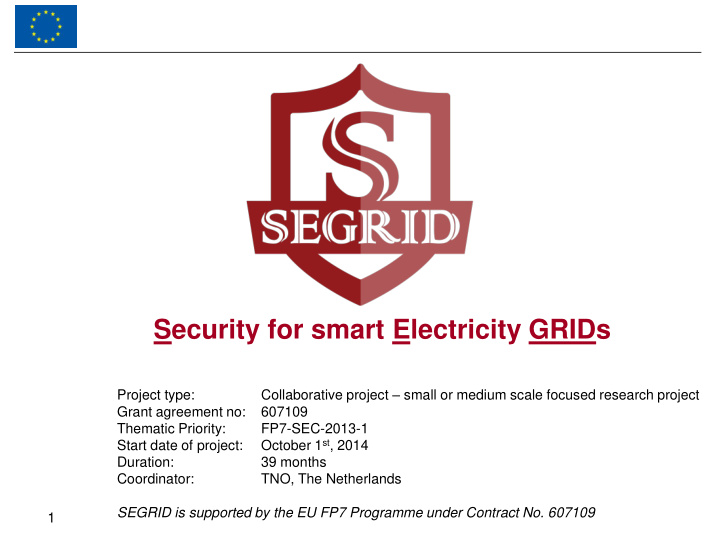



Security for smart Electricity GRIDs Collaborative project – small or medium scale focused research project Project type: Grant agreement no: 607109 Thematic Priority: FP7-SEC-2013-1 October 1 st , 2014 Start date of project: Duration: 39 months Coordinator: TNO, The Netherlands SEGRID is supported by the EU FP7 Programme under Contract No. 607109 1
SEGRID Partners Distribution System Operators Manufacturers Knowledge institutes Universities 2
SEGRID Distribution over Europe 3
SEGRID Project targets 1. Identifying threats and potential future cyber-attack pathways, for the SEGRID use cases; 2. Determining the gap between currently available security for smart grids and what is needed for the SEGRID use cases; 3. Developing the necessary new security methods and measures for privacy, communication and system security in smart grids; 4. Building up a realistic test environment (Security Integration Test Environment, SITE) to test and verify new security methods and measures; 5. Evaluating and improving current risk management methodologies in order to make them optimally suited to identify and address the key risk factors of smart grids of 2020; 6. Feeding the established results from the SEGRID project into European and global standardisation bodies, industry groups and smart grid suppliers. 4
SEGRID Storyline Level of (smart) automation Gaps in currently available security SOLL technology for the Smart Grid Smart Energy Grid New threats security is insufficient 5) Automatic reconfiguration Current state of 4) Load balancing regionally Known 3) Dynamic power management threats 2) Load balancing centrally 1) Smart Metering IST Current Energy Grid Time 5
SEGRID Work package structure M1 M1 M1 WP 2 (ABB) Use cases and security goals Application & Enhancements of Risk Assessment Testing and evaluation M1 WP 5 (ENCS) WP 1 (EDP) WP 3 (KTH) Enhancements of Vulnerability Assessment techn. M3 WP 4 (SICS) Novel Security Solutions T4.1 System T4.2 Comm. T4.3 Resilient T4.4 Privacy & Platform protocols Comm. infra by design M1 WP 6 (TNO) Dissemination & Exploitation M1 WP 7 (TNO) Project management 6
SEGRID Use cases and security goals Level of (smart) automation Gaps in currently available security SOLL technology for the Smart Grid Smart Energy Grid New threats security is insufficient 5) Automatic reconfiguration Current state of 4) Load balancing regionally Known 3) Dynamic power management threats Functional architecture for UCs using SGAM 2) Load balancing centrally Security & Privacy goals for UCs 1) Smart Metering IST Current Energy Grid Time 7
SEGRID Application & enhancement of Risk assessment Level of (smart) automation Gaps in currently available security SOLL technology for the Smart Grid Smart Energy New Grid threats security is insufficient 5) Automatic reconfiguration Risk Assessments Current state of on use cases to 4) Load balancing regionally • identify gaps in Known current security 3) Dynamic power management threats technologies • assess RA tools 2) Load balancing centrally (e.g. M/490 SGIS RA, 1) Smart Metering EURAM) IST Current Energy Grid Time 8
SEGRID Develop vulnerability assessment technologies WP3 (KTH) Vulnerability assessment tools T3.1 Enhancement of T3.2 Automatic model T3.3 software vulnerability CySeMol generation discovery & diagnosis Cyber Security Modelling Language (CySeMoL) SecuriCAD • Developed by KTH in FP7 Viking • Tool for assessing vulnerabilities in system architecture (using probabilistic attack graphs) • SEGRID has enhanced the tool by • extending functionality more towards smart grids (e.g. use cases), and • automatic model generation 9
SEGRID Develop novel security solutions (to fill some of the gaps) WP4 (SICS) Novel Security Solutions T4.1 System & T4.2 Comm. T4.3 Resilient T4.4 Privacy Platform protocols Comm. infra by design ▪ Design the SEGRID Security and Privacy Architecture , that includes security life-cycle management ▪ Current WP4 activities on novel security solutions a) Trusted Platform b) Resilient SCADA systems c) IDS and authentication in mesh networks d) Resilient communication infrastructure e) Robustness and scalable (D)TLS-based communication f) Key management for group software distribution g) Privacy by design 10
SEGRID Develop novel security solutions (to fill some of the gaps) WP4 (SICS) Novel Security Solutions T4.1 System & T4.2 Comm. T4.3 Resilient T4.4 Privacy Platform protocols Comm. infra by design Robustness and scalable (D)TLS-based communication K MS Problem: • (D)TLS handshake (cookie exchange) is vulnerable for DoS attack. • Pre-shared key establishment scales poorly • SICS developed a solution that resolves both problems 11
SEGRID Develop novel security solutions (to fill some of the gaps) WP4 (SICS) Novel Security Solutions T4.1 System & T4.2 Comm. T4.3 Resilient T4.4 Privacy Platform protocols Comm. infra by design Resilient comm. infrastructure • Goal: Develop a number of mechanisms to support resilient communication infrastructure under attack and/or with accidental failures. • SEGRID is developing technology for adaptive probing and monitoring to select the “best” available routes enabling rapid reaction after failures. • Scope: SCADA Primary Substation 12
SEGRID Security Integration Test Environment (SITE) SCADA (WP3) & secure wireless communication Robustness and scalable D(T)LS- based communication Resilient communications infrastructure Key management for group software distribution Resilient SCADA systems 13
Questions Mail: info@segrid.eu Website: www.segrid.eu Telephone: +31 8886 67758 Project Coordinator: Technical Coordinator: Frank Fransen Reinder Wolthuis Reinder Wolthuis Reinder Wolthuis Reinder Wolthuis +31 6 53 72 49 00 +31 6 5191 33 79 +31 6 5191 33 79 +31 6 5191 33 79 +31 6 5191 33 79 reinder.wolthuis@tno.nl reinder.wolthuis@tno.nl reinder.wolthuis@tno.nl reinder.wolthuis@tno.nl frank.fransen@tno.nl 14
Recommend
More recommend